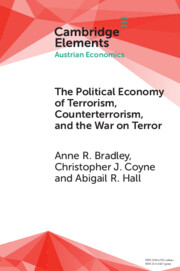61 results

The Political Economy of Terrorism, Counterterrorism, and the War on Terror
-
- Published online:
- 09 August 2023
- Print publication:
- 31 August 2023
-
- Element
- Export citation
Evaluating automated electronic case report form data entry from electronic health records
-
- Journal:
- Journal of Clinical and Translational Science / Volume 7 / Issue 1 / 2023
- Published online by Cambridge University Press:
- 14 December 2022, e29
-
- Article
-
- You have access
- Open access
- HTML
- Export citation
Teaching principles of translational science to a broad scientific audience using a case study approach: A pilot course from the National Center for Advancing Translational Sciences
-
- Journal:
- Journal of Clinical and Translational Science / Volume 6 / Issue 1 / 2022
- Published online by Cambridge University Press:
- 21 March 2022, e66
-
- Article
-
- You have access
- Open access
- HTML
- Export citation
Bilingual Aspects of the Ontogenesis Model: Parasitic Connections at all Levels of Representation?
-
- Journal:
- Bilingualism: Language and Cognition / Volume 25 / Issue 2 / March 2022
- Published online by Cambridge University Press:
- 18 August 2021, pp. 208-209
-
- Article
- Export citation
A history of high-power laser research and development in the United Kingdom
- Part of
-
- Journal:
- High Power Laser Science and Engineering / Volume 9 / 2021
- Published online by Cambridge University Press:
- 27 April 2021, e18
-
- Article
-
- You have access
- Open access
- HTML
- Export citation
Contributors
-
- Book:
- Ontologies of English
- Published online:
- 24 December 2019
- Print publication:
- 02 January 2020, pp xii-xvi
-
- Chapter
- Export citation
Contents
-
- Book:
- Ontologies of English
- Published online:
- 24 December 2019
- Print publication:
- 02 January 2020, pp vii-ix
-
- Chapter
- Export citation
Figures
-
- Book:
- Ontologies of English
- Published online:
- 24 December 2019
- Print publication:
- 02 January 2020, pp x-x
-
- Chapter
- Export citation
Part VII - Commentary and Conclusions
-
- Book:
- Ontologies of English
- Published online:
- 24 December 2019
- Print publication:
- 02 January 2020, pp 353-376
-
- Chapter
- Export citation
Acknowledgements
-
- Book:
- Ontologies of English
- Published online:
- 24 December 2019
- Print publication:
- 02 January 2020, pp xix-xix
-
- Chapter
- Export citation
Dedication
-
- Book:
- Ontologies of English
- Published online:
- 24 December 2019
- Print publication:
- 02 January 2020, pp v-vi
-
- Chapter
- Export citation
Part III - English in Schools
-
- Book:
- Ontologies of English
- Published online:
- 24 December 2019
- Print publication:
- 02 January 2020, pp 99-162
-
- Chapter
- Export citation
Tables
-
- Book:
- Ontologies of English
- Published online:
- 24 December 2019
- Print publication:
- 02 January 2020, pp xi-xi
-
- Chapter
- Export citation
Part IV - Assessing English
-
- Book:
- Ontologies of English
- Published online:
- 24 December 2019
- Print publication:
- 02 January 2020, pp 163-230
-
- Chapter
- Export citation
Part V - English in Lingua Franca Contexts
-
- Book:
- Ontologies of English
- Published online:
- 24 December 2019
- Print publication:
- 02 January 2020, pp 231-292
-
- Chapter
- Export citation
Part I - Introduction
-
- Book:
- Ontologies of English
- Published online:
- 24 December 2019
- Print publication:
- 02 January 2020, pp 1-36
-
- Chapter
- Export citation
Index
-
- Book:
- Ontologies of English
- Published online:
- 24 December 2019
- Print publication:
- 02 January 2020, pp 377-382
-
- Chapter
- Export citation
Part II - English in/for L2 Learning and Teaching
-
- Book:
- Ontologies of English
- Published online:
- 24 December 2019
- Print publication:
- 02 January 2020, pp 37-98
-
- Chapter
- Export citation
Copyright page
-
- Book:
- Ontologies of English
- Published online:
- 24 December 2019
- Print publication:
- 02 January 2020, pp iv-iv
-
- Chapter
- Export citation
Transcription Conventions
-
- Book:
- Ontologies of English
- Published online:
- 24 December 2019
- Print publication:
- 02 January 2020, pp xx-xx
-
- Chapter
- Export citation



